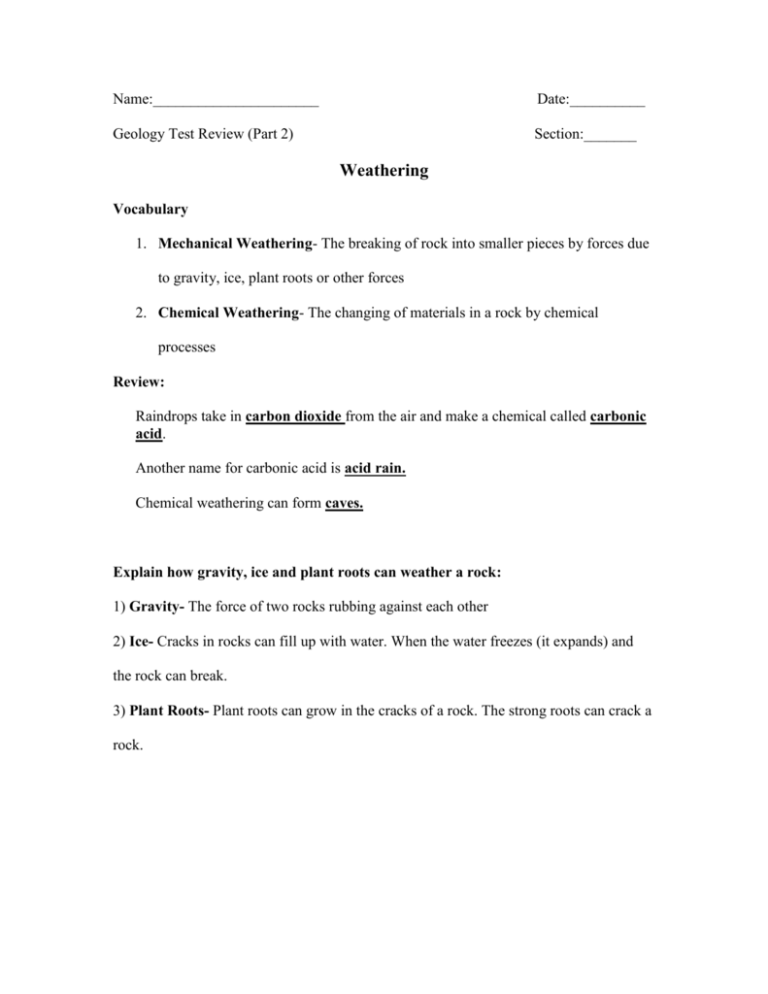Name: Date - St. Anne`s School
advertisement

Name:______________________ Date:__________ Geology Test Review (Part 2) Section:_______ Weathering Vocabulary 1. Mechanical Weathering- The breaking of rock into smaller pieces by forces due to gravity, ice, plant roots or other forces 2. Chemical Weathering- The changing of materials in a rock by chemical processes Review: Raindrops take in carbon dioxide from the air and make a chemical called carbonic acid. Another name for carbonic acid is acid rain. Chemical weathering can form caves. Explain how gravity, ice and plant roots can weather a rock: 1) Gravity- The force of two rocks rubbing against each other 2) Ice- Cracks in rocks can fill up with water. When the water freezes (it expands) and the rock can break. 3) Plant Roots- Plant roots can grow in the cracks of a rock. The strong roots can crack a rock. Erosion Vocabulary: Erosion- The destructive process of moving materials away from one place. Deposition- The constructive process of placing materials in a new place. Explain wave, wind and field erosion: 1) Wave Erosion- Waves hit against rocks. Sand and Gravel in the waves act like sand paper. 2) Wind Erosion- Wind blows dust, sand or soil that hit against rocks. This may make rock formations in arches. 3) Field Erosion- Plants dig their roots deep into the soil. When a field is bare, the wind can blow the top soil off. Review: 1. Farmers try to prevent field erosion from happening by planting trees. 2. Top soil is the best kid of soil for growing crops. It cannot be quickly replaced. 3. When rocks are in the shape of an arch this would mean that wind erosion has taken place. 4. Glaciers are big bodies of ice that can cause erosion. Minerals Vocabulary: 1) Mineral- a natural solid whose particles make a pattern. Review 1. Soil and rocks are made out of minerals. 2. The Mohs scale is used to tell how hard a mineral is. 3. Talc is that softest mineral (1) and diamond is the hardest mineral (10). 4. Chalk is made out of talc. 5. Luster is that way a mineral’s surface reflects light. 6. Not all minerals have a specific shape. 7. A minerals streak is usually different from the minerals outside color. What are the 6 properties scientists use to identify minerals? 1. Hardness 2. Magnetism 3. Luster 4. Shape 5. Streak 6. Texture Rocks Vocabulary 1) Rocks- Are made up of different kinds of minerals 2) Sediments- Pieces of broken rocks 3) Rock Cycle- A cycle where rocks can change from one kind to another Types of Rocks 1) Igneous- Rocks that form when melted rock cools and hardens. Forms inside or outside a volcano 2) Sedimentary- Rocks that form when layers of materials and rock particles settle on top of each other and then harden. 3) Metamorphic- Rocks that form when solid rock is squeezed and heated to a very high temperature. Formed from igneous or sedimentary rocks. Review 1) Mineral crystals form as hot rock cools. Large crystals form when the rock cools slowly (granite) and small crystals form when they cool quickly (basalt). Large Crystals Small Crystals Cooling- Cool slowly (inside a volcano) Cool quickly (outside a volcano) Example- Granite Example- Basalt - Looks spotted - One color - Many colors - Black 2) Sandstone and conglomerate are two examples of sedimentary rocks 3) Fossils usually form in sedimentary rocks 4) Metamorphic rocks form from igneous and sedimentary rocks. * Review rock cycle diagram*








